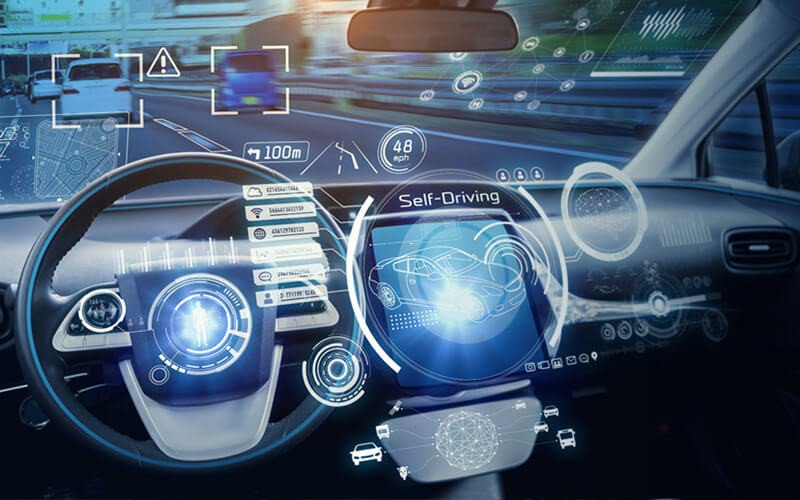
The race to build an autonomous vehicle is heating up, especially as the 5G network becomes more widespread in the United States. 5G is at least ten times faster than its 4G equivalent and boasts of three features that find a variety of applications: enhanced mobile broadband; massive machine-type communication and reliable low-latency communications.
It is this last advantage, the low-latency configuration, that finds ready use in autonomous vehicles, Latency, defined as the time between sending and receiving information, in 5G dips down to an impressive 1 millisecond. You need such low latencies in instances where split-second decision-making happens at the “edge” as in the autonomous vehicle.
Efficiently incorporating 5G’s potential in autonomous vehicles, however, is a challenge. It will require a rethink in terms of electronic design and associated components. Automakers — and their electronic components supplier partners — will need to understand how the vehicle itself is fundamentally shifting gears and becoming a data superhighway. That in turn will affect the kinds of electronics that can be reliably sourced and used.
Enter V2X Communications
The road to the fully autonomous vehicle is made up of incremental steps — the training wheels are still squarely on — but its primary premise is built on data driving all decisions. V2X communications, where “X” stands for cloud, vehicle, infrastructure or pedestrian, will require extensive electronics on board.
V2C will host security and firmware updates and information as well as entertainment options. V2V will ensure adequate spacing between cars, work to avoid accidents in non-line of sight scenarios, such as blind spots, and deliver predictive smooth traffic flows. V2P will be needed to work with pedestrians who want to cross the road, and who might even wear or tote communication devices of their own. V2I communicates with satellites, sensors at traffic lights or other key data points for updated near-time reports on congestion so traffic can be diverted more easily and efficiently.V2I can also help find parking more easily.
The V2X ecosystem includes a number of modules: Controller area network (CAN) mechanisms with microcontrollers; global navigation satellite system and cellular antenna, the transmission control unit (TCU) and more.
Design and Connectivity Implications
All these levels of communication will need connectivity, which in turn will need a whole slew of electronic components. The design of autonomous vehicles that can harness the power of 5G will have to consider many factors. These include:
Redundant architectures: Electronic subsystems, in the near future at least, will be divided into discrete blocks each with its own set of sensors, actuators and other electronic components. These architecture building blocks will attend to functions such as safety, motion, infotainment and advanced driver assistance systems (ADAS). It is quite possible that in the distant future, functions between these fundamental building blocks will overlap, in which case the arrangement of electronic components will have to be reconfigured, too, in order to meet new demands.
Miniaturization and power density: LIDAR and radar cameras, sensors, display units and more make up the innards of an autonomous vehicle – but designers can’t simply keep piling them all up. As the number of electronic components increases, the space available to contain them will not. Costs have to be kept low as well. Electronic components that can enable effective use of 5G technology for the autonomous vehicle run into challenges related to power density, where components have to do more with less.
Weight is also a critical factor. As more vehicles become electrified and the battery itself adds some weight, the rest of the components will have to be lighter to compensate.
Low EMI: The increase in the number of electronic components will also increase incidences of electromagnetic interference (EMI), something safety-critical missions simply can’t afford because of related negative performance. Adding more passive capacitors to circuits is not an option as costs and weight considerations again come into play. Electronic components for the autonomous vehicle will need to address the EMI problem through new designs of sensors or by playing with the arrangements of components to minimize incidences.
Finally, original automotive equipment manufacturers (OEMs) will also need to meet the vast connectivity requirements for the autonomous vehicle — 5G is a blessing in that regard — and facilitate efficient use of sensors and radio communications.
Sourcing electronic components for these new automotive applications will be challenging for a variety of reasons. While the traditional factors of cost, safety and reliability will have to be considered, of course, it’s also important that suppliers understand the evolution of the autonomous vehicle and 5G. The (likely) rocky road to complete integration between 5G and the truly autonomous vehicle will need an experienced hand in procurement – one who keeps a pulse on the latest technology developments in a rapidly evolving field.
The fully autonomous vehicle is still a few years away, but manufacturing ecosystems are already gearing up for an exciting ride ahead.
Statements of fact and opinions expressed in posts by contributors are the responsibility of the authors alone and do not imply an opinion of the officers or the representatives of TTI, Inc. or the TTI Family of Companies.

